December 2025

The global ambulatory healthcare services market size was calculated at USD 928.95 billion in 2025, to reach USD 979.21 billion in 2026 is expected to be worth USD 1492.54 billion by 2035, expanding at a CAGR of 5.41% from 2026 to 2035. The rising prevalence of chronic disorders, growing demand for enhanced patient outcomes, and technological advancements drive the market.
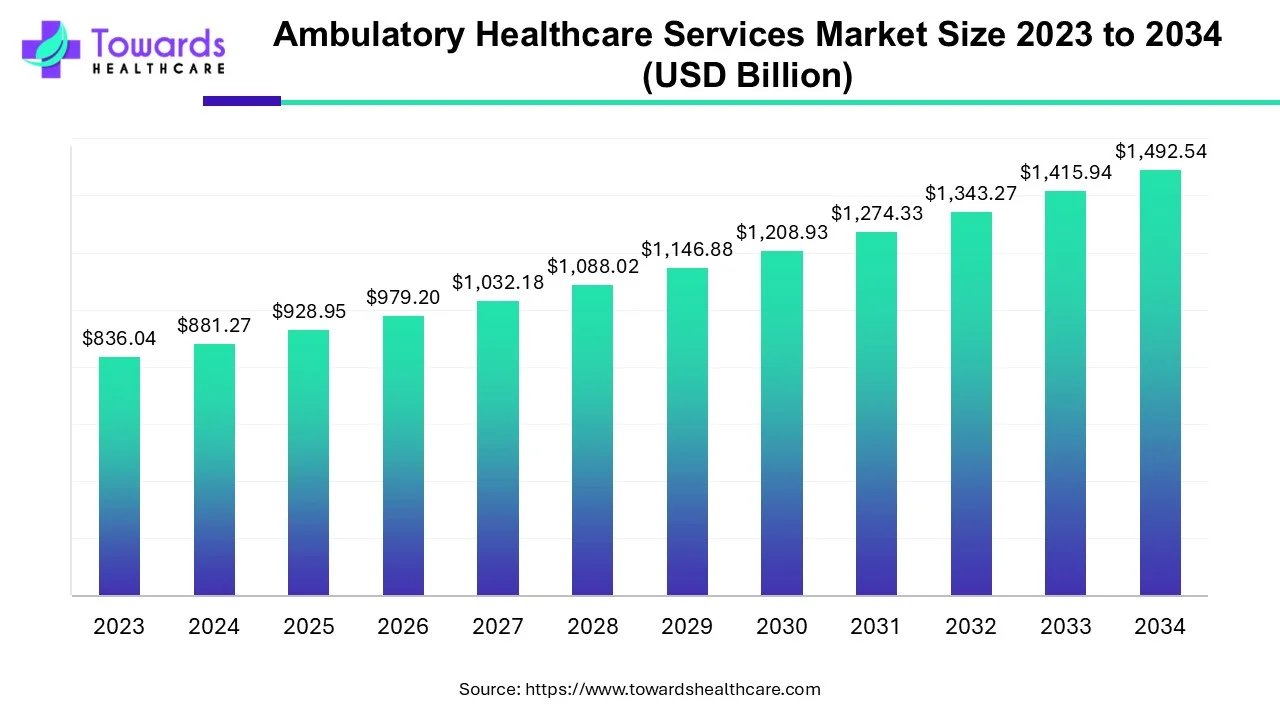
Any same-day medical operation performed in an outpatient environment is considered Ambulatory Care. This term refers to any medical care that is not provided in a hospital or institution where admission is required. Ambulatory service centers (ASC) are also known as outpatient care facilities. These are outpatient medical care institutions that offer consultation, diagnostic, treatment, and intervention services. Ophthalmology, orthopedics, gastroenterology, plastic surgery, pain management, obstetrics, and many other disciplines are available at ASC.
| Metric | Details |
| Market Size in 2025 | USD 928.95 Billion |
| Projected Market Size in 2035 | USD 1573.3 Billion |
| CAGR (2026 - 2035) | 5.41% |
| Leading Region | North America |
| Market Segmentation | By Type, By Application, By Region |
| Top Key Players | Amsurg, Aspen Pharmacare, AQuity Solutions, Envision Healthcare Corporation, Healthway Medical Group, Medical Facilities Corporation, NueHealth, Sheridan Healthcare, Surgery Partners, Surgical Care Affiliates, Terveystalo Healthcare |
Artificial intelligence (AI) revolutionizes the healthcare sector, providing modern facilities to ambulatory care clinics. AI can be used in the effective diagnosis and treatment of diseases. AI enables healthcare professionals to make timely clinical decisions and design tailored treatments for patients, improving treatment outcomes. AI can also interpret patient requests and information in context and ensure patients receive appropriate instructions for self-care. AI and machine learning (ML) tools can manage patient appointments and other administrative tasks in an outpatient setting. AI tools such as cloud-based services can also store large amounts of patient medical data, eliminating the need to store and manage physical reports. AI and ML enhance the overall patient experience by providing real-time monitoring and predicting patient outcomes.
Growing Demand for Minimally Invasive Surgeries
The major growth factor of the ambulatory healthcare services market is the growing demand for minimally invasive surgeries. Minimally invasive surgeries involve smaller cuts or incisions and a few stitches in the body. Smaller incisions in minor surgeries like endoscopies, cataract surgeries, or some cosmetic procedures. Ambulatory healthcare services majorly focus on minimally invasive surgeries. These surgeries lead to faster recovery times and reduced costs. Additionally, these surgeries possess lower infection risks. The rising adoption of advanced technologies such as laparoscopy and robots in ambulatory healthcare services attracts more patients to opt for ambulatory services.
Factors Fueling the Market Growth
The increasing elderly population and rising incidence of chronic diseases, increased demand for less invasive operations, and technological developments are the primary factors driving the growth of the ambulatory healthcare service market. Chronic illness prevalence is rising globally, owing to an aging population and the increased lifetime of patients with chronic disorders. Along with a growth in the number of patients suffering from particular diseases, the prevalence of multi-morbidity, or the presence of various diseases in the same person, is increasing. Sedentary lifestyles are increasing obesity rates and the prevalence of numerous ailments.
Creating A Secure Communication Route
Due to the increased use of automated EHR technology and the trend toward healthcare unification and medical information interchange, the landscape of medical security and privacy has grown. Increased electronic exchange of patient records boosts accessibility and efficacy while raising data liability and risk due to its broad reach. The widespread sharing of patient data increases the chance of security breaches by introducing security and privacy risks.
Approximately one-third of data theft in the health business culminates in clinical identity fraud, which is mostly caused by a lack of control environment surrounding health information, out-of-date rules and processes, or a failure to follow those that currently exist.
The Advancement of the Cloud System has Created New Commercial Opportunities
Due to the development of the software platform, healthcare firms all around the world now have new company skills and prospects. Cloud-based solutions are increasingly preferred by providers and consumers over on-premise systems. Some advantages of cloud-based solutions for medical organizations include improved patient information exchange, lower start-up costs, on-demand resource availability, simple installation and scalability, and quick installation.
Complex Systems Can Be Implemented In Simple, Useable Ways
The extensive usage of cloud technology in the healthcare sector gives organizations the much-needed freedom to expand abroad. The ability of networks to handle more complex data is allowing for the growth of interconnections. Large amounts of data will be maintained in the cloud, simplifying mobile user architecture and allowing for the deployment of sophisticated technologies in a user-friendly way. These advantages are expected to provide significant development potential for portable EHR systems in the future years.
Due to the increasing need for ambulatory healthcare services, several hospitals have established outpatient facilities to meet the public's healthcare demands. A hospital-owned outpatient center may be located within the hospital or elsewhere.
Patients on Medicare save costs when they seek ambulatory care from ASCs. Ambulatory healthcare, when provided under the authority of a hospital, is subject to the institution's policies, including fees and price structures. This usually results in greater patient expenditures than when the same ambulatory healthcare service is delivered at a separate ASC.
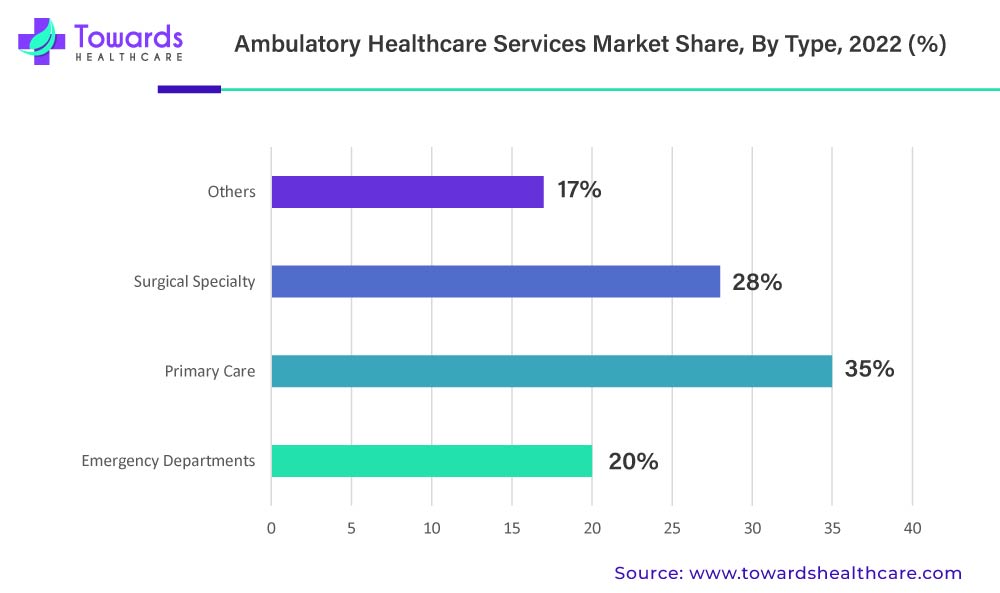
By type, the surgical specialty segment is anticipated to grow with the highest CAGR in the market during the studied years. The rising prevalence of chronic disorders and the availability of specialized equipment drive the segment’s growth. Ambulatory services also possess suitable infrastructure and skilled professionals. Interventional pain management procedures, orthopedic surgeries, urologic surgeries, gynecologic surgeries, and many more can be performed in an ambulatory surgical center.
The ambulatory services market is divided into four types: primary care offices, emergency departments, surgical specialties, and medical specialties. Primary care offices dominated the market in 2018 as a result of better treatment quality and the use of new technology such as computerized prescription systems and Electronic Health Records (EHRs). The use of EHR in rural regions, as well as drug procurement, has enhanced primary and follow-up treatment, minimizing manual mistakes. Collaborations between big government and commercial organizations to give low-cost access to various treatments are projected to drive growth in the ambulatory services industry.
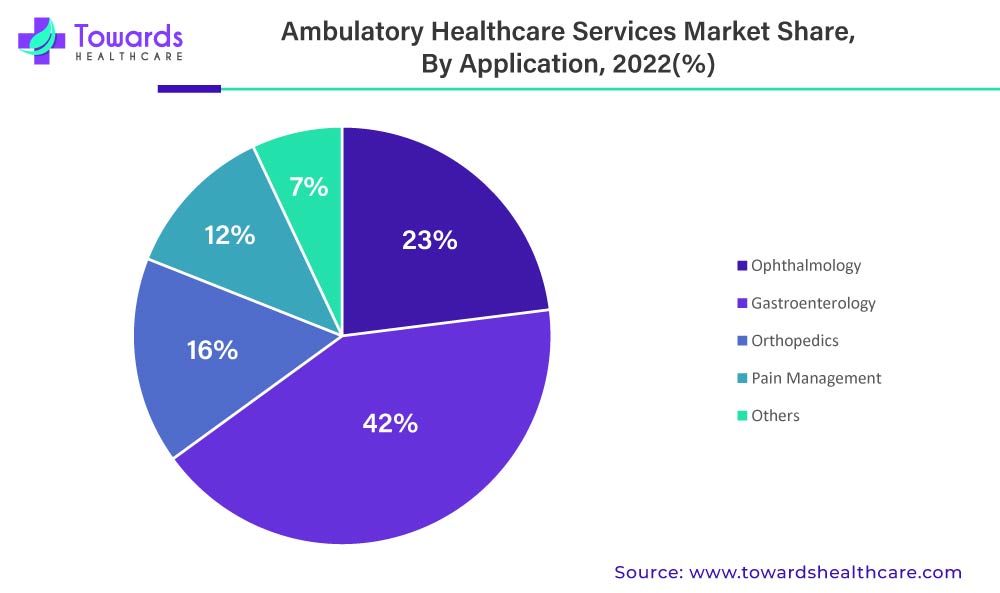
By application, the ophthalmology segment is projected to expand rapidly in the market in the coming years. The rising prevalence of ocular disorders and favorable government policies support the segment’s growth. Ambulatory services offer efficient and cost-effective solutions for numerous eye conditions. Cataract surgery, LASIK, and glaucoma surgeries are usually performed in outpatient care settings. Several government organizations launches initiatives to screen people with visual impairment and initiate early treatment.
One of the primary reasons driving market expansion is the increasing frequency of gastrointestinal illnesses. Sedentary lifestyles are becoming more popular, which is increasing the number of patients suffering from digestive problems. Rising incidences of digestive illnesses are likely to produce a large demand for ambulatory healthcare services throughout the predicted period. As a result of the increasing frequency of digestive illnesses, there may be a significant need for emergency care and ambulatory services throughout the projection period.
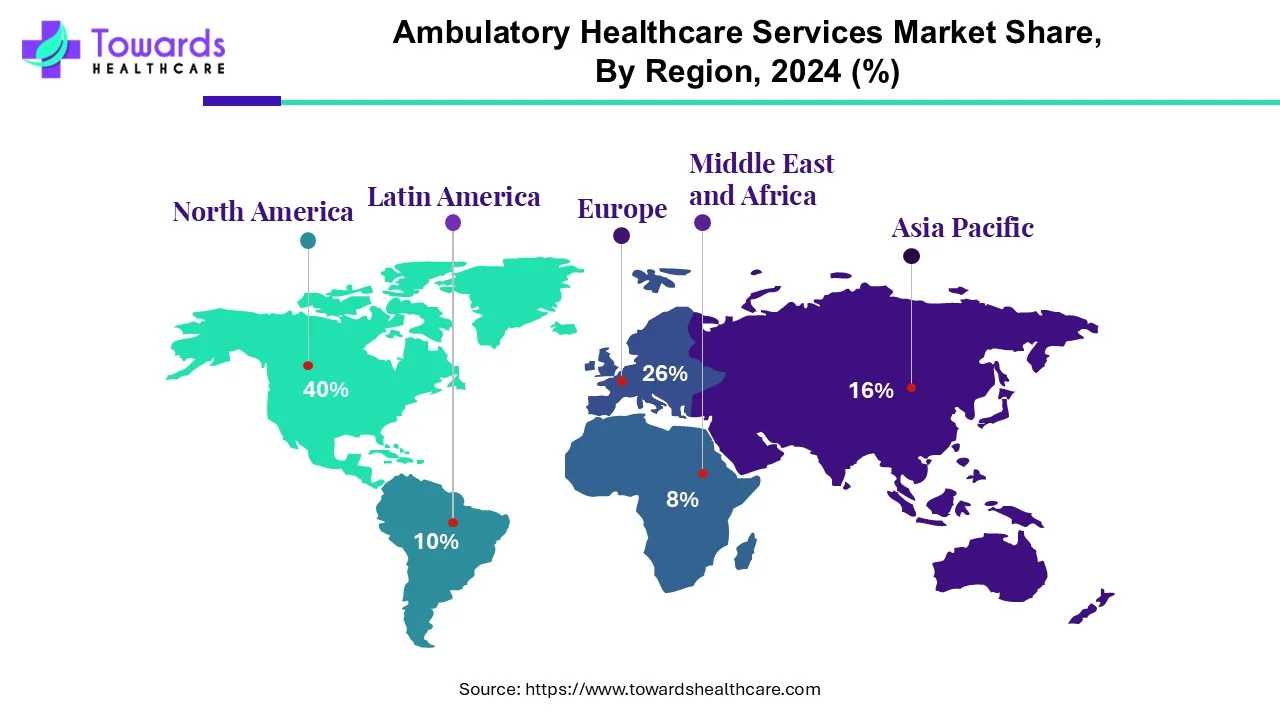
In 2024, North America led the worldwide market, accounting for over 40% of the market. This is due to the rapid acceptance of technologically improved items. Government efforts and mergers and acquisitions are expected to propel the regional industry even further. The increasing number of ambulatory healthcare services in the U.S. and Canada, owing to their rising demand, also potentiates the market. There are a total of 741,907 establishments in ambulatory healthcare services, as of the second quarter of 2024. The increasing investments also contribute to the market. The U.S. Department of Health and Human Services announced an investment of $60 million in 125-HRSA-funded community health centers in 2025.
Asia-Pacific is projected to host the fastest-growing ambulatory healthcare services market in the coming years. The rising prevalence of chronic disorders, growing awareness for ambulatory services, and increasing investments drive the market. Favorable government support potentiates the Asia-Pacific market. The Indian Government aims to raise healthcare spending by 2.5% of GDP by 2025. The Chinese Government has also made provisions for foreign investors to invest in China’s healthcare ecosystem. The availability of favorable reimbursement policies also promotes the market. The growing demand for outpatient services and the rising medical tourism sector augment market growth.
Europe is a notable region in the ambulatory healthcare services market due to a growing demand for convenient and cost-effective healthcare, the increasing prevalence of chronic diseases, and technological advancements like telemedicine. Europe also has a strong regulatory framework where the EU has a strong focus on healthcare regulations, including data protection (GDPR), and there is also a drift towards admitting private providers to operate with less rigorous regulations. Furthermore, many European countries have universal healthcare systems, either directly through taxation or through subsidized social health insurance, with better-financed healthcare.
For instance,
In January 2024, Tom Langan, President and Chief Commercial Officer at Veradigm, announced the acquisition of Koha Health. This acquisition brings additional Musculoskeletal Medicine specialty subject matter expertise to the Veradigm Network, as well as an improved ability to deliver revenue cycle services to ambulatory healthcare provider practices and ambulatory surgical centers employing various electronic health record systems.
In November 2024, Brandon K. Sim, President and CEO of Astrana, announced that it entered into a definitive agreement to acquire Prospect Health, including its California Prospect Health Plan, Medical Groups, Prospect Medical Systems, RightRx, and Alta Newport Hospital. The partnership between Astrana and Prospect helps to ensure that healthcare remains local and personalized for patients.
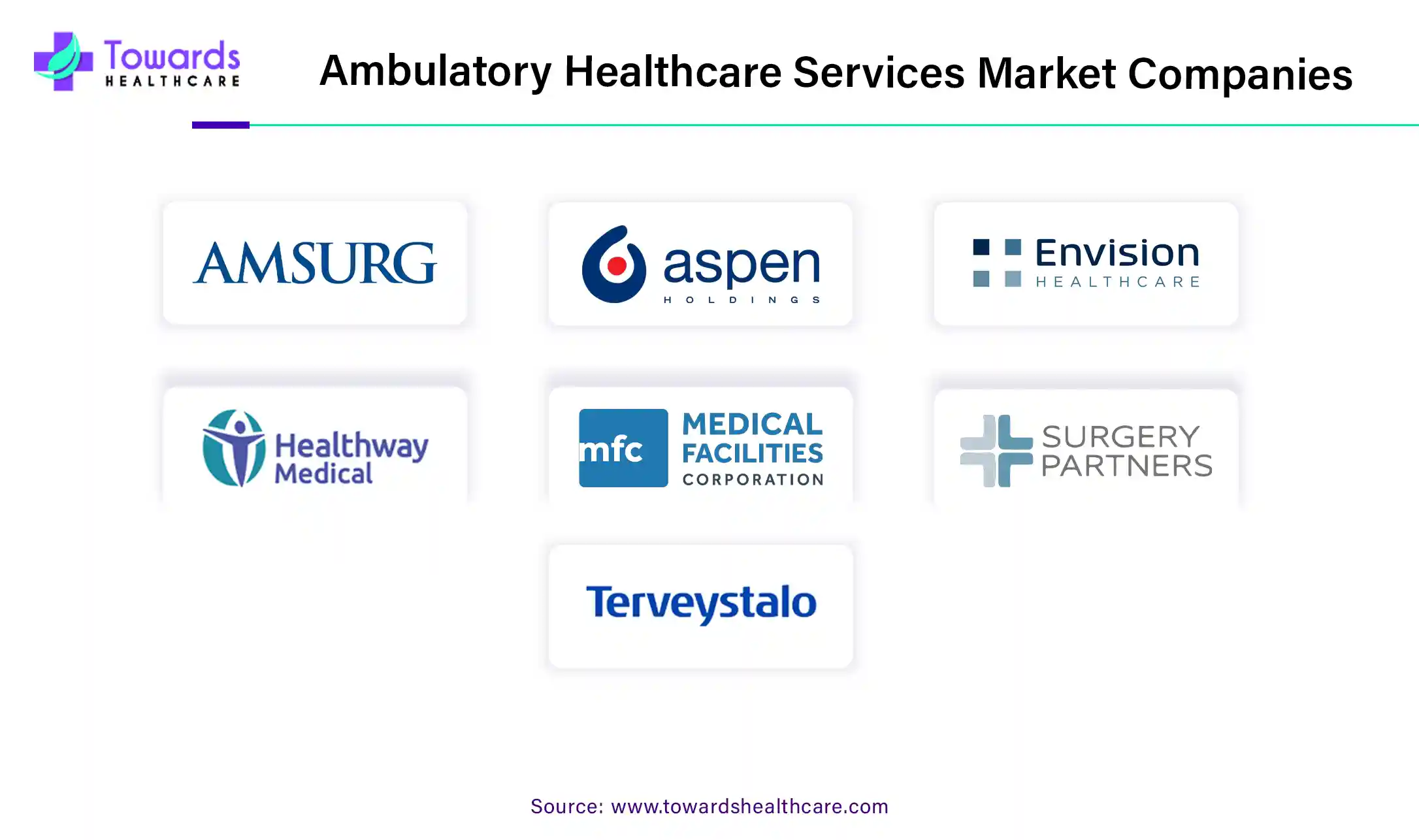
Saum Sutaria, CEO of Tenet Healthcare Corporation, told investors that Tenet was entering a “new era” in which ambulatory surgical businesses generated a higher proportion of its performance. Same-facility revenue for ambulatory services grew 9.2% during 2023, above the company’s long-term goal of 4% to 6% top-line growth. The company reported $20.5 billion in operating revenue for the full fiscal year 2023.
Ambulatory healthcare services have increased in significance in US healthcare facilities, as has the requirement for simplified and automated compliance processes. Compliance is equally as critical in ambulatory healthcare as it is in hospitals. Working from numerous ASCs or hospital outpatient facilities increases a doctor's capacity to make revenue and give prompt treatment alternatives to patients where and when they are needed.
By Type
By Application
By Region
December 2025
December 2025
December 2025
December 2025